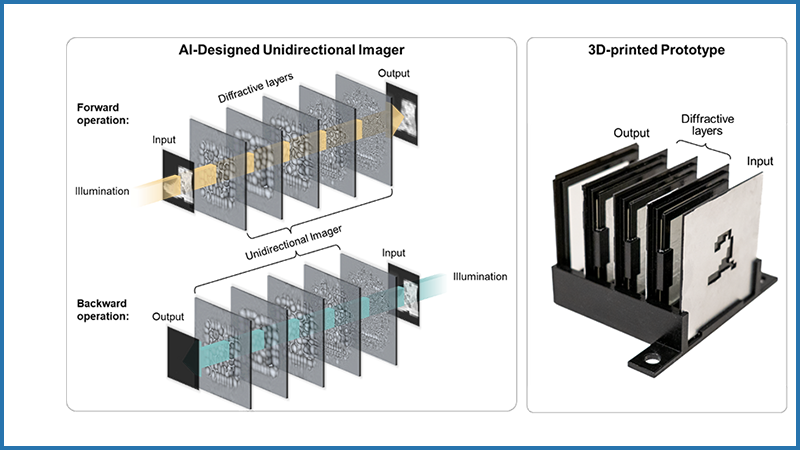Traditional optical imaging and communication systems, typically composed of lenses, perform imaging operations in both forward and backward directions. Similar to a pipe that enables liquid to flow through from one end to the other in both directions, standard optical materials and lenses allow light to travel both ways through devices such as a camera.
A research team at the UCLA Samueli School of Engineering recently invented a new unidirectional material to break this paradigm in optical imaging. The researchers used artificial intelligence (AI) to structurally engineer materials with details at scales smaller than the wavelength of light. The result is an imager design through which imaging is only possible in one direction, while being blocked from the other.
Published today in Science Advances, the paper titled “Unidirectional Imaging Using Deep Learning-Designed Materials” delineates the innovative optical imager design consisting of a series of transmissive optical layers through the spatial engineering of materials using deep learning.
“This AI-driven engineering of the material leads to the formation of multiple structured, transparent layers that collectively modulate the optical waves with an asymmetric behavior in the forward and backward imaging directions,” said study lead Aydogan Ozcan, a UCLA Samueli professor of electrical and computer engineering.
“This AI-driven engineering of the material leads to the formation of multiple structured, transparent layers that collectively modulate the optical waves with an asymmetric behavior in the forward and backward imaging directions,” said study lead Aydogan Ozcan, a UCLA Samueli professor of electrical and computer engineering and holder of UCLA’s Volgenau Chair for Engineering Innovation. “The resulting unidirectional imager allows image formation from an input field of view to an output field of view, but not the other way around. The reverse path for image formation is blocked.”
Even under broadband light composed of many wavelengths, the unidirectional imager can maintain its functionality despite being trained using a single illumination wavelength. This unidirectional imaging capability is also independent of light polarization and works under any orientation of light oscillations. In their experiments, the researchers successfully demonstrated the design’s efficacy on a 3D-printed multilayered imager by exposing it to terahertz radiation. The team also designed a separate imager that allowed a user to choose which direction the image should be blocked by selecting a specific wavelength. For example, at one wavelength, the image formation only works from left to right, while at a different wavelength, the reversed path is the only direction from which the image can be seen.
This wavelength-multiplexed design enhances the unidirectional imager’s capability and flexibility, allowing it to function like a switchboard to control the transmission of information coded in light waves. Unidirectional imagers can operate at any part of the electromagnetic spectrum using different transmissive materials or substrates, and they are very thin — with a few tens of wavelengths in thickness, which, in the visible spectrum, would correspond to the thickness of a stamp. These unidirectional imagers could have a significant impact on various fields, including security, defense and telecommunications.
Funded by the Office of Naval Research and Burroughs Wellcome Fund, the study was conducted in collaboration with Mona Jarrahi, holder of UCLA’s Northrop Grumman Endowed Chair in electrical and computer engineering. Both Jarrahi and Ozcan are members of the California NanoSystems Institute at UCLA, with Ozcan serving as its associate director. Ozcan also holds faculty appointments in the Department of Bioengineering and the David Geffen School of Medicine at UCLA. Other authors of the paper are graduate students Jingxi Li, Tianyi Gan, Yifan Zhao, Bijie Bai, Che-Yung Shen and Songyu Sun — all members of Ozcan’s and Jarrahi’s research labs at UCLA.

